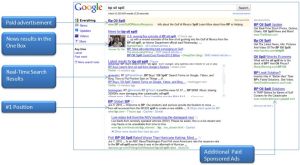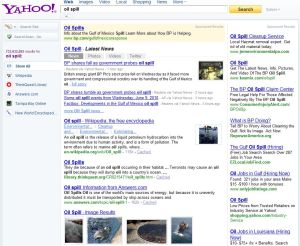BP Oil Spill Search Marketing
Let’s open with this statement: this post will only discuss BP’s use of search marketing as it pertains to the Oil Spill. We all have our opinions and emotions about what’s happened, how it’s being dealt with and what might yet transpire. This post will focus on the role of search engine marketing is playing at BP in this catastrophe.
In Wake of Oil Spill, is BP “Manipulating” Search Engine Results?
A recent headline states, “BP ‘Manipulating Search Results’ On Google Following Oil Spill.” The text in the article doesn’t do much to set the record straight; however.
Without a doubt, BP is using PPC search marketing to attempt to provide BP-specific information to internet users. Their ads appear at the top of all major search engines. A quick check of natural search engine positions on high-volume search keywords reveals that BP’s website SEO efforts have not achieved great success.
The image here illustrates BP’s #1 position on the branded keyword phrase, “BP Oil Spill.” We found BP.com positioned on page-5 in Google on the non-branded term “oil spill” and page-3 for “Gulf of Mexico oil spill.” Other rankings were tough to find at all.

BP Search Marketing Results
The image above also calls-out the abundant opportunities BP has to position their web properties as part of their crisis management response plan. Notice news releases in the “one box”, real-time search, and BP’s only #1 position – on a branded keyword term, “BP oil spill.”
The phrase “manipulating search engine results” brings to mind the dark days for BMW.com following their experience with “door way pages.” Given BP’s poor SEO performance, it’s tough to imagine how someone could draw the conclusion that BP is manipulating search engine results. For example, let’s look at search results without the BP brand absent from the search phrase:

Yahoo BP Oil Spill Search Marketing
There are search marketing tactics that BP could employee to earn more and better rankings; for starters:
On-page and in-code website optimization
- Align page titles descriptions with high-volume keywords
- Label and tag images, links and headlines with relevant keywords
Although BP is utilizing social media, there’s little attempt to tag content with important keywords
- In Flickr, images are not tagged nor do they have keyword-rich captions
- In Facebook and Twitter, BP has not employed tags to make it easy to find BP related web content
There are other tactics that could be employed to help improve BP’s search engine positions, but the results and quick view of their efforts clearly indicate BP is not engaged in manipulation of natural search results.
The amount of material that has been made available already is impressive. There have been scores of people in BP and at multiple agencies deployed to manage online and offline communications surrounding this catastrophe. Online, BP is utilizing Pay-per-click search marketing, Twitter, Facebook, Flickr, and more. Too bad for BP website SEO isn’t getting the same attention the quick-hit tactics seem to be getting.
However, some have questioned BP’s disaster preparedness. That should lead you to question your company’s disaster preparedness and communications in crisis management mode. Is your team up-to-speed and ready to deploy your PR machine in the wake of a business interruption or disaster? Do you have that plan developed, well-communicated and accessible to the right employees?
If not, what are you doing about it?
References:
BP ‘Manipulating Search Results’ On Google Following Oil Spill as reported by:
BMW Expelled from Google, Online Media Daily, February 6, 2006.
Learn more about WorldLink Marketing, online marketing consultants.




 Posted by worldlinkmarketing
Posted by worldlinkmarketing 



 Subscribe to our feed!
Subscribe to our feed!